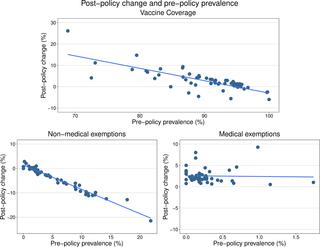Our official English website, www.x-mol.net, welcomes your feedback! (Note: you will need to create a separate account there.)
The 2016 California policy to eliminate nonmedical vaccine exemptions and changes in vaccine coverage: An empirical policy analysis.
PLOS Medicine ( IF 15.8 ) Pub Date : 2019-12-23 , DOI: 10.1371/journal.pmed.1002994 Sindiso Nyathi 1 , Hannah C Karpel 2 , Kristin L Sainani 1 , Yvonne Maldonado 1, 3 , Peter J Hotez 4, 5, 6, 7 , Eran Bendavid 8 , Nathan C Lo 9
PLOS Medicine ( IF 15.8 ) Pub Date : 2019-12-23 , DOI: 10.1371/journal.pmed.1002994 Sindiso Nyathi 1 , Hannah C Karpel 2 , Kristin L Sainani 1 , Yvonne Maldonado 1, 3 , Peter J Hotez 4, 5, 6, 7 , Eran Bendavid 8 , Nathan C Lo 9
Affiliation

|
BACKGROUND
Vaccine hesitancy, the reluctance or refusal to receive vaccination, is a growing public health problem in the United States and globally. State policies that eliminate nonmedical ("personal belief") exemptions to childhood vaccination requirements are controversial, and their effectiveness to improve vaccination coverage remains unclear given limited rigorous policy analysis. In 2016, a California policy (Senate Bill 277) eliminated nonmedical exemptions from school entry requirements. The objective of this study was to estimate the association between California's 2016 policy and changes in vaccine coverage.
METHODS AND FINDINGS
We used a quasi-experimental state-level synthetic control analysis and a county-level difference-in-differences analysis to estimate the impact of the 2016 California policy on vaccination coverage and prevalence of exemptions to vaccine requirements (nonmedical and medical). We used publicly available state-level data from the US Centers for Disease Control and Prevention on coverage of measles, mumps, and rubella (MMR) vaccination, nonmedical exemption, and medical exemption in children entering kindergarten. We used county-level data individually requested from state departments of public health on overall vaccine coverage and exemptions. Based on data availability, we included state-level data for 45 states, including California, from 2011 to 2017 and county-level data for 17 states from 2010 to 2017. The prespecified primary study outcome was MMR vaccination in the state analysis and overall vaccine coverage in the county analysis. In the state-level synthetic control analysis, MMR coverage in California increased by 3.3% relative to its synthetic control in the postpolicy period (top 2 of 43 states evaluated in the placebo tests, top 5%), nonmedical exemptions decreased by 2.4% (top 2 of 43 states evaluated in the placebo tests, top 5%), and medical exemptions increased by 0.4% (top 1 of 44 states evaluated in the placebo tests, top 2%). In the county-level analysis, overall vaccination coverage increased by 4.3% (95% confidence interval [CI] 2.9%-5.8%, p < 0.001), nonmedical exemptions decreased by 3.9% (95% CI 2.4%-5.4%, p < 0.001), and medical exemptions increased by 2.4% (95% CI 2.0%-2.9%, p < 0.001). Changes in vaccination coverage across counties after the policy implementation from 2015 to 2017 ranged from -6% to 26%, with larger increases in coverage in counties with lower prepolicy vaccine coverage. Results were robust to alternative model specifications. The limitations of the study were the exclusion of a subset of US states from the analysis and the use of only 2 years of postpolicy data based on data availability.
CONCLUSIONS
In this study, implementation of the California policy that eliminated nonmedical childhood vaccine exemptions was associated with an estimated increase in vaccination coverage and a reduction in nonmedical exemptions at state and county levels. The observed increase in medical exemptions was offset by the larger reduction in nonmedical exemptions. The largest increases in vaccine coverage were observed in the most "high-risk" counties, meaning those with the lowest prepolicy vaccine coverage. Our findings suggest that government policies removing nonmedical exemptions can be effective at increasing vaccination coverage.
中文翻译:

2016 年加州取消非医疗疫苗豁免和疫苗覆盖范围变化的政策:实证政策分析。
背景技术疫苗犹豫,即不愿或拒绝接受疫苗接种,是美国和全球日益严重的公共卫生问题。消除儿童疫苗接种要求的非医学(“个人信仰”)豁免的国家政策存在争议,而且鉴于严格的政策分析有限,其提高疫苗接种覆盖率的有效性仍不清楚。2016 年,加州政策(参议院第 277 号法案)取消了入学要求中的非医疗豁免。本研究的目的是评估加州 2016 年政策与疫苗覆盖率变化之间的关联。方法和结果 我们使用准实验州级综合控制分析和县级双重差分分析来估计 2016 年加州政策对疫苗接种覆盖率和疫苗要求豁免流行率(非医疗和医疗)的影响。我们使用了美国疾病控制与预防中心公开的州级数据,了解进入幼儿园的儿童的麻疹、腮腺炎和风疹 (MMR) 疫苗接种覆盖率、非医疗豁免和医疗豁免情况。我们使用了州公共卫生部门单独要求的关于疫苗总体覆盖率和豁免的县级数据。根据数据可用性,我们纳入了 2011 年至 2017 年包括加利福尼亚州在内的 45 个州的州级数据以及 2010 年至 2017 年 17 个州的县级数据。预先指定的主要研究结果是州分析中的 MMR 疫苗接种情况和总体疫苗情况县域分析的覆盖范围。在州级综合对照分析中,加州的 MMR 覆盖率相对于政策后时期的综合对照增加了 3.3%(安慰剂测试评估的 43 个州中排名前 2 的,前 5%),非医疗豁免减少了 2.4%(安慰剂测试中评估的 43 个州中排名前 2 的州,排名前 5%),医疗豁免增加了 0.4%(安慰剂测试中评估的 44 个州中排名前 1 的州,排名前 2%)。在县级分析中,总体疫苗接种覆盖率增加了 4.3%(95% 置信区间 [CI] 2.9%-5.8%,p < 0.001),非医疗豁免减少了 3.9%(95% CI 2.4%-5.4%,p < 0.001),医疗豁免增加了 2.4% (95% CI 2.0%-2.9%,p < 0.001)。2015年至2017年政策实施后各县疫苗接种覆盖率变化范围为-6%至26%,政策前疫苗覆盖率较低的县覆盖率增幅较大。结果对于替代模型规格来说是稳健的。该研究的局限性在于分析中排除了美国部分州,并且根据数据可用性仅使用了政策实施后 2 年的数据。结论 在这项研究中,加州取消非医疗儿童疫苗豁免政策的实施与州和县一级疫苗接种覆盖率的估计增加和非医疗豁免的减少有关。观察到的医疗豁免的增加被非医疗豁免的大幅减少所抵消。在“高风险”程度最高的县(即政策前疫苗覆盖率最低的县),疫苗覆盖率增幅最大。我们的研究结果表明,取消非医疗豁免的政府政策可以有效提高疫苗接种覆盖率。
更新日期:2020-01-14
中文翻译:

2016 年加州取消非医疗疫苗豁免和疫苗覆盖范围变化的政策:实证政策分析。
背景技术疫苗犹豫,即不愿或拒绝接受疫苗接种,是美国和全球日益严重的公共卫生问题。消除儿童疫苗接种要求的非医学(“个人信仰”)豁免的国家政策存在争议,而且鉴于严格的政策分析有限,其提高疫苗接种覆盖率的有效性仍不清楚。2016 年,加州政策(参议院第 277 号法案)取消了入学要求中的非医疗豁免。本研究的目的是评估加州 2016 年政策与疫苗覆盖率变化之间的关联。方法和结果 我们使用准实验州级综合控制分析和县级双重差分分析来估计 2016 年加州政策对疫苗接种覆盖率和疫苗要求豁免流行率(非医疗和医疗)的影响。我们使用了美国疾病控制与预防中心公开的州级数据,了解进入幼儿园的儿童的麻疹、腮腺炎和风疹 (MMR) 疫苗接种覆盖率、非医疗豁免和医疗豁免情况。我们使用了州公共卫生部门单独要求的关于疫苗总体覆盖率和豁免的县级数据。根据数据可用性,我们纳入了 2011 年至 2017 年包括加利福尼亚州在内的 45 个州的州级数据以及 2010 年至 2017 年 17 个州的县级数据。预先指定的主要研究结果是州分析中的 MMR 疫苗接种情况和总体疫苗情况县域分析的覆盖范围。在州级综合对照分析中,加州的 MMR 覆盖率相对于政策后时期的综合对照增加了 3.3%(安慰剂测试评估的 43 个州中排名前 2 的,前 5%),非医疗豁免减少了 2.4%(安慰剂测试中评估的 43 个州中排名前 2 的州,排名前 5%),医疗豁免增加了 0.4%(安慰剂测试中评估的 44 个州中排名前 1 的州,排名前 2%)。在县级分析中,总体疫苗接种覆盖率增加了 4.3%(95% 置信区间 [CI] 2.9%-5.8%,p < 0.001),非医疗豁免减少了 3.9%(95% CI 2.4%-5.4%,p < 0.001),医疗豁免增加了 2.4% (95% CI 2.0%-2.9%,p < 0.001)。2015年至2017年政策实施后各县疫苗接种覆盖率变化范围为-6%至26%,政策前疫苗覆盖率较低的县覆盖率增幅较大。结果对于替代模型规格来说是稳健的。该研究的局限性在于分析中排除了美国部分州,并且根据数据可用性仅使用了政策实施后 2 年的数据。结论 在这项研究中,加州取消非医疗儿童疫苗豁免政策的实施与州和县一级疫苗接种覆盖率的估计增加和非医疗豁免的减少有关。观察到的医疗豁免的增加被非医疗豁免的大幅减少所抵消。在“高风险”程度最高的县(即政策前疫苗覆盖率最低的县),疫苗覆盖率增幅最大。我们的研究结果表明,取消非医疗豁免的政府政策可以有效提高疫苗接种覆盖率。



























 京公网安备 11010802027423号
京公网安备 11010802027423号